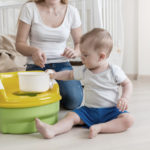Childproofing your home: A checklist for parents

Bumps and bruises are a part of growing up. But serious injuries can cause lasting damage. By making a few adjustments around your house, you can help your child stay safe and healthy at home.
We spoke to Dr. Katherine Shearer of Longwood Pediatrics, part of Boston Children’s Primary Care Alliance, about keeping kids safe while at home. She offers advice for caregivers of infants, toddlers, and older children.
Infants
The number-one safety concern for infants is how they sleep. Dr. Shearer reminds parents to place newborns on their backs and keep their cribs empty. “That means no toys, stuffed animals, sheets, blankets, or crib bumpers,” she says.
Pay special attention to your baby’s safety during:
- Bath time: Set your home’s water temperature to no hotter than 120 degrees.
- Playtime: Avoid toys with small parts. Older siblings should keep their toys off the floor, especially LEGOs and anything with small pieces.
- Mealtime: Once they’re old enough, seat your child in a highchair for all meals.
Toddlers
Around the 12-month mark, children are more mobile and more curious about their living environment. “It’s impossible to watch your toddler 100 percent of the time, even with the best intentions,” Dr. Shearer says.
Extra precautions can help keep little explorers safe. Dr. Shearer recommends:
- using safety gates to block access to stairs
- locking cabinets that contain sharp items or chemicals
- placing cords behind furniture to prevent pulling
- installing cordless blinds
- keeping small toys and objects, such as button batteries, that can be serious choking hazards out of reach
- mounting TVs, dressers, shelves, and other furniture that can be tipped over
- using child-resistant covers on trash cans
“A climbing child can tip over a piece of furniture, which can lead to serious and even fatal injuries,” Dr. Shearer explains. “Once your child is walking, go from room to room and figure out which items are heavy. Furniture with a lot of drawers and anything top-heavy should be anchored to the wall.”
She also recommends paying attention to the medicine cabinet. Even items that aren’t at ground level can be reached by toddlers. “Keep all medicine out of sight and reach. Liquid nicotine, cannabis edibles, and other potentially harmful substances should be stored away from the kitchen, in a locked cabinet,” she notes.
Older children
Dr. Shearer advises parents to be proactive with older children. Help them get their energy out in a safe way.
“Kid-safe spaces are great,” she says. “Fill a lower kitchen drawer with Tupperware or spoons — items that can be pulled out and played with. Or you can create an area in your house with cushions and pillows so they can climb around safely.”
Make sure they’re getting enough exercise. Outdoor physical activity can reduce the likelihood of unsafe indoor behavior.
Just like with toddlers, older children should not be able to access:
- medication
- alcohol
- nicotine products
- cleaning supplies
- kitchen or gardening tools
- firearms
Dr. Shearer recommends talking to older children about safety. Discuss the importance of staying away from unsafe items. Be sure to communicate with babysitters and other caregivers about dangerous items in your home to keep the children away from when they are in their care, too. “Explain that something is dangerous and that they shouldn’t go near it,” she advises. “In a clear and age-appropriate way, let them know if something could hurt them or make them sick.”
Safety checklist
Children of all ages should be in a safe environment. Make sure your home has:
- smoke detectors
- fire extinguishers
- carbon monoxide detectors
- covers for electrical outlets
- a well-stocked first aid kit
- a fire escape plan
- visible emergency phone numbers
If you must bring these items into your home, keep them secured and out of reach:
- firearms and other weapons
- matches and lighters
- button batteries
- liquid laundry packets
- plastic or dry-cleaning bags
Boston Children’s Primary Care Alliance providers offer advice to keep you and your child safe. Find a pediatrician near you.
Related Posts :
-

Sweet dreams: A guide to infant sleep
While sleep should be peaceful, ensuring your baby is sleeping safely — and soundly — can be stressful. We spoke with Shana ...
-

Top tips for water safety
As summer approaches, families head outdoors for fun ways to beat the heat. One of the most cherished summertime activities ...
-

The dos and don’ts of potty training
Eager as parents may be to start potty training, it can be a period filled with a lot of uncertainty ...
-

Send your kids to camp with peace of mind: Safety guidelines to look for this summer
After this past year, it may be hard to remember what a “normal” summer feels like, but as communities reopen, ...





